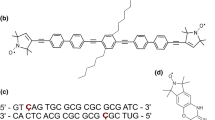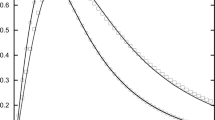Abstract
An algorithm is proposed for deriving the position of a stable radical relative to a photoexcited quartet state from the electron spin–spin interactions measured by double resonance methods. Intersystem crossing generates multiplet polarization in the quartet state and microwave excitation of the ±3/2 ↔ ±1/2 transitions converts the multiplet polarization into net polarization of the ±1/2 levels. The dependence of the electron spin echo envelope modulation (ESEEM) of the +1/2 ↔ −1/2 transition on the field/frequency of the stimulation pulse is demonstrated. The algorithm is tested by comparing the predicted ESEEM patterns to those from explicit numerical calculations of the spin evolution (so-called numerical experiments), which act as a model for experiment results. The comparison demonstrates that within the point-dipole approximation it is feasible to obtain not only the distance between the two paramagnetic centers but also the orientation of the distance vector relative to the principal axes of the quartet state.








Similar content being viewed by others
References
W.L. Hubbell, C. Altenbach, Curr. Opin. Struc. Biol. 4, 566–573 (1994)
G. Jeschke, Y. Polyhach, Phys. Chem. Chem. Phys. 9, 1895–1910 (2007)
J.P. Klare, H.J. Steinhoff, Photosynth. Res. 102, 377–390 (2009)
O. Schiemann, T.F. Prisner, Q. Rev. Biophys. 40, 1–53 (2007)
R.G. Larsen, D.J. Singel, J. Chem. Phys. 98, 5134–5146 (1993)
A.D. Milov, A.G. Maryasov, Y.D. Tsvetkov, Appl. Magn. Reson. 15, 107–143 (1998)
A.D. Milov, A.B. Ponomarev, Y.D. Tsvetkov, Chem. Phys. Lett. 110, 67–72 (1984)
A.D. Milov, K.M. Salikhov, M.D. Shchirov, Fiz. Tverd. Tela 23, 957–982 (1981)
A.M. Raitsimring, K.M. Salikhov, Bull. Magn. Reson. 7, 1184–1217 (1985)
L.V. Kulik, S.A. Dzuba, I.A. Grigoryev, Y.D. Tsvetkov, Chem. Phys. Lett. 343, 315–324 (2001)
S. Milikisyants, F. Scarpelli, M.G. Finiguerra, M. Ubbink, M. Huber, J. Magn. Reson. 201, 48–56 (2009)
V.V. Kurshev, A.V. Astashkin, A.M. Raitsimring, J. Struct. Chem. 29, 62–68 (1988)
S. Saxena, J.H. Freed, Chem. Phys. Lett. 251, 102–110 (1996)
V.P. Denysenkov, D. Biglino, W. Lubitz, T.F. Prisner, M. Bennati, Angew. Chemie 47, 1224–1227 (2008)
V.P. Denysenkov, T.F. Prisner, J. Stubbe, M. Bennati, Proc. Natl. Acad. Sci. USA 103, 13386–13390 (2006)
M.M. Hertel, V.P. Denysenkov, M. Bennati, T.F. Prisner, Magn. Reson. Chem. 43, S248–S255 (2005)
J.E. Lovett, A.M. Bowen, C.R. Timmel, M.W. Jones, J.R. Dilworth, D. Caprotti, S.G. Bell, L.L. Wong, J. Harmer, Phys. Chem. Chem. Phys. 11, 6840–6848 (2009)
D. Margraf, B.E. Bode, A. Marko, O. Schiemann, T.F. Prisner, Mol. Phys. 105, 2153–2160 (2007)
A.G. Maryasov, Y.D. Tsvetkov, J. Raap, Appl. Magn. Reson. 14, 101–113 (1998)
Y. Polyhach, A. Godt, C. Bauer, G. Jeschke, J. Magn. Reson. 185, 118–129 (2007)
A. Savitsky, A.A. Dubinskii, M. Flores, W. Lubitz, K. Mobius, J. Phys. Chem. B 111, 6245–6262 (2007)
I. Kaminker, I. Tkach, N. Manukovsky, T. Huber, H. Yagi, G. Otting, M. Bennati, D. Goldfarb, J. Magn. Reson. 227, 66–71 (2013)
Y.E. Kandrashkin, A. van der Est, Appl. Magn. Reson. 40, 189–204 (2011)
K. Ishii, J. Fujisawa, Y. Ohba, S. Yamauchi, J. Am. Chem. Soc. 118, 13079–13080 (1996)
K. Ishii, T. Ishizaki, N. Kobayashi, J. Chem. Soc.-Dalton Trans., 3227–3231 (2001)
K. Ishii, S. Takeuchi, N. Kobayashi, J. Phys. Chem. A 105, 6794–6799 (2001)
Y. Kandrashkin, M.S. Asano, A. van der Est, Phys. Chem. Chem. Phys. 8, 2129–2132 (2006)
Y.E. Kandrashkin, M.S. Asano, A. van der Est, J. Phys. Chem. A 110, 9607–9616 (2006)
Y.E. Kandrashkin, M.S. Asano, A. van der Est, J. Phys. Chem. A 110, 9617–9626 (2006)
Y. Teki, M. Kimura, S. Narimatsu, K. Ohara, K. Mukai, Bull. Chem. Soc. Jpn. 77, 95–99 (2004)
Y. Teki, M. Nakatsuji, Y. Miura, Int. J. Mod. Phys. B 15, 4029–4031 (2001)
R.L. Ake, M. Gouterman, Theor. Chim. Acta 15, 20–42 (1969)
Y. Kandrashkin, A. van der Est, J. Chem. Phys. 120, 4790–4799 (2004)
Y.E. Kandrashkin, A. van der Est, Appl. Magn. Reson. 40, 189–204 (2011)
S.N. Trukhan, V.F. Yudanov, V.M. Tormyshev, O.Y. Rogozhnikova, D.V. Trukhin, M.K. Bowman, M.D. Krzyaniak, H. Chen, O.N. Martyanov, J. Magn. Reson. 233, 29–36 (2013)
A. van der Est, M. Asano-Someda, P. Ragogna, Y. Kaizu, J. Phys. Chem. A 106, 8531–8542 (2002)
G.E. Pake, J. Chem. Phys. 16, 327–336 (1948)
G. Jeschke, V. Chechik, P. Ionita, A. Godt, H. Zimmermann, J. Banham, C.R. Timmel, D. Hilger, H. Jung, Appl. Magn. Reson. 30, 473–498 (2006)
P.K. Poddutoori, M. Pilkington, A. Alberola, V. Polo, J.E. Warren, A. van der Est, Inorg. Chem. 49, 3516–3524 (2010)
G. Jeschke, H.W. Spiess, Lect. Notes Phys. 684, 21–63 (2006)
Acknowledgments
This work was supported by a grant from the Natural Sciences and Engineering Research Council, Canada, and by the Russian Foundation for Basic Research (project no. 12-03-97078).
Author information
Authors and Affiliations
Corresponding authors
Appendix
Appendix
In the following we calculate analytical expressions for the ESEEM curves of the weakly coupled quartet–doublet system. We assume that the detection pulses excite the +1/2 ↔ −1/2 transitions of both the quartet and the doublet spins and we neglect the influence of the MW field on the transitions +3/2 ↔ +1/2 and −3/2 ↔ −1/2 of the quartet state. In the case of no initial coherence, the spin echo depends only on the differences of the populations of the sublevels ±1/2
In the simple case of weak dipolar interactions between two spins the evolution of the spin system is described by the static spin Hamiltonian:
Here we ignore ZFS of the quartet state because it does not affect the results under the approximation used. The ESE signal is computed as:
where p 1 and p 2 describe the pulses and depend on the applied pulse sequence. In the following, we will neglect those terms in the solution of (29) that depend on the Larmor frequencies ω Q or ω R at time t = τ. The solutions of Eqs. (29) for the four pulse sequences labeled as A, B, C, and R described in the main text [Eqs. (16) and (25)] are:
1. Pulse sequence A [Eq. (16)]
The pulses p 1 and p 2 of pulse sequence A are defined according to Eqs. (12), (14) and (15) as:
The ESE signal computed according to Eq. (29) gives:
2. Pulse sequence B [Eq. (16)]
The pulses p 1 and p 2 of pulse sequence B are defined according to Eqs. (12) and (14) as:
3. Pulse sequence C [Eq. (16)]
The pulses p 1 and p 2 of pulse sequence C are defined according to Eq. (12) and are used to detect the primary spin echo predominantly from spin Q:
4. Pulse sequence [Eq. (25)]
The pulses p 1 and p 2 of this pulse sequence are defined according to Eq. (12) and are used to detect primary spin echo from spin R:
Rights and permissions
About this article
Cite this article
Kandrashkin, Y.E., van der Est, A. Orientation Information from the Dipolar Interaction Between a Complex in the Excited Quartet State and a Doublet Spin Label. Appl Magn Reson 45, 217–237 (2014). https://doi.org/10.1007/s00723-014-0516-8
Received:
Revised:
Published:
Issue Date:
DOI: https://doi.org/10.1007/s00723-014-0516-8




